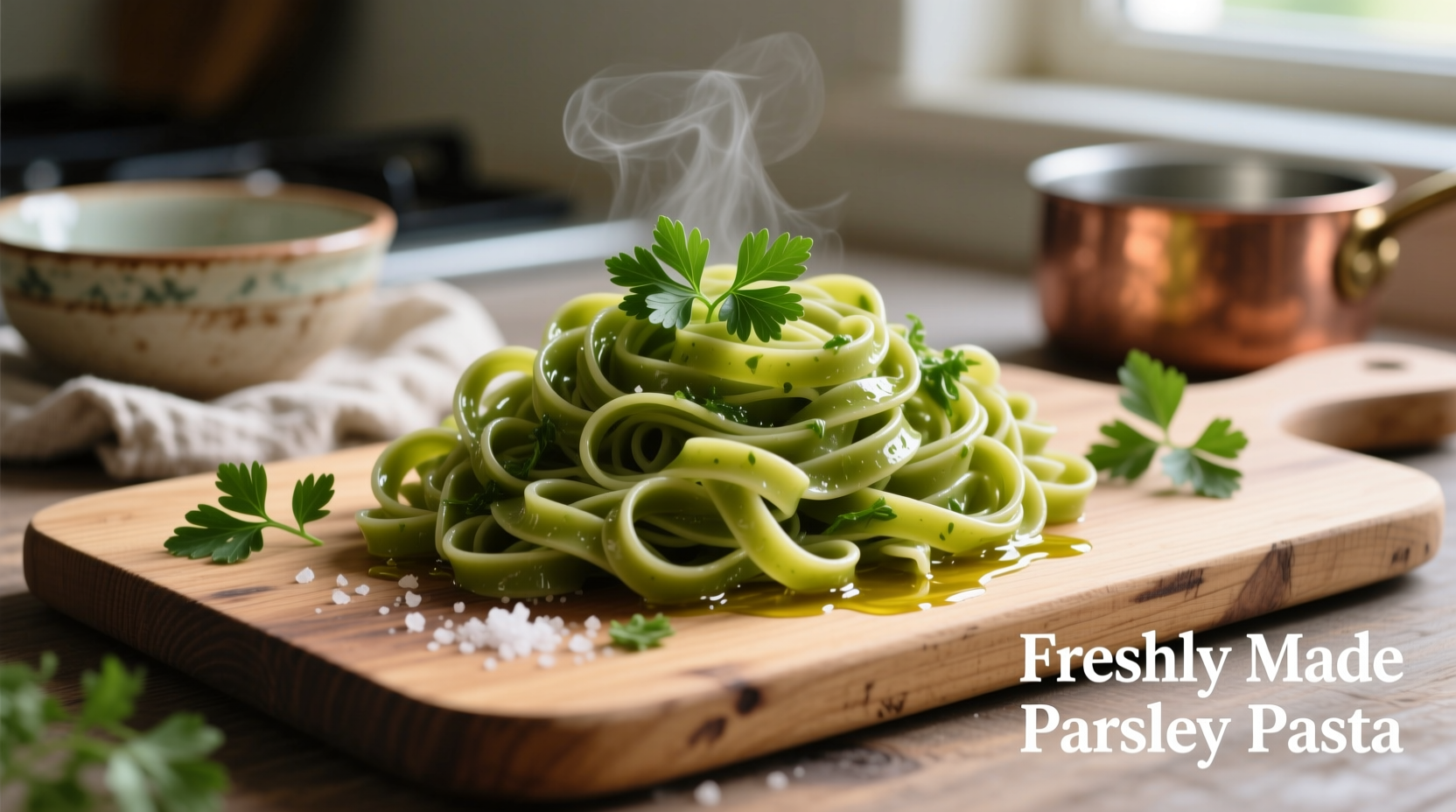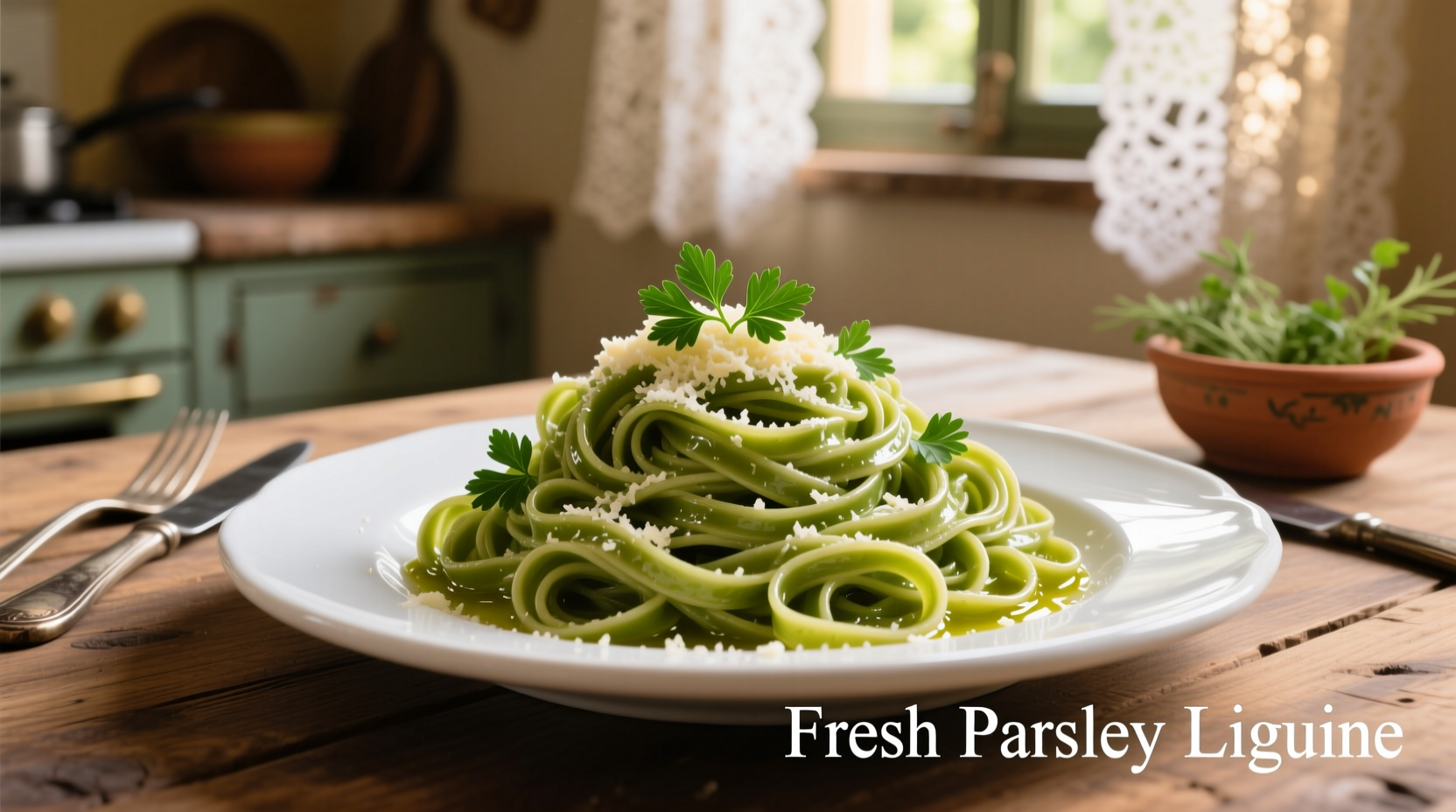Parsley pasta is fresh pasta dough infused with finely chopped flat-leaf parsley, creating vibrant green noodles with a subtle herbal flavor that enhances Mediterranean dishes without overpowering other ingredients. This traditional Italian preparation method dates back centuries and offers both visual appeal and nutritional benefits compared to plain pasta.
Have you ever wondered how to elevate your pasta dishes with natural color and flavor? Parsley pasta transforms ordinary noodles into a restaurant-quality centerpiece through a simple yet precise technique. In this guide, you'll discover the authentic method for making parsley pasta that maintains its vibrant color and delicate herbal notes, plus learn which dishes showcase this specialty pasta best.
The Origins of Parsley in Italian Pasta Tradition
While modern food enthusiasts might view parsley pasta as a contemporary trend, its roots run deep in Italian culinary history. Historical records from the Barilla Academy show that Italian cooks began incorporating fresh herbs into pasta dough as early as the 15th century, particularly in regions like Liguria and Tuscany where parsley grows abundantly.
| Historical Period | Parsley Pasta Development | Regional Significance |
|---|---|---|
| 1400-1500s | First documented herb-infused pasta recipes | Ligurian coastal communities used local flat-leaf parsley |
| 1600-1700s | Spread to inland regions with seasonal variations | Tuscan cooks incorporated parsley during spring harvests |
| 1800s | Standardized in regional cookbooks | Appeared in Pellegrino Artusi's seminal Italian cookbook |
| Modern Era | Global popularity with authentic technique preservation | Recognized by Italian culinary institutions as traditional preparation |
Why Parsley Pasta Outperforms Regular Pasta
The difference between ordinary pasta and properly made parsley pasta extends beyond mere appearance. When crafted using traditional methods, parsley pasta delivers three distinct advantages:
- Enhanced flavor complexity - The natural compounds in parsley (particularly myristicin and apiol) interact with wheat proteins to create subtle earthy notes that complement seafood and vegetable sauces
- Nutritional boost - According to USDA FoodData Central, just 1/4 cup of fresh parsley adds significant amounts of vitamin K (20% DV), vitamin C (10% DV), and folate (5% DV) to your pasta serving
- Visual presentation - The vibrant green color signals freshness to diners, triggering positive sensory expectations before the first bite

The Authentic Method: Crafting Parsley Pasta That Retains Its Color
Many home cooks make the mistake of simply adding parsley to their pasta dough without understanding the chemistry involved. The key to maintaining that beautiful green color lies in proper preparation technique. Here's the professional approach:
Essential Ingredients and Ratios
For authentic results, maintain this precise ratio:
- 300g (2½ cups) tipo "00" flour
- 3 large eggs
- 40g (½ cup packed) fresh flat-leaf parsley, finely minced
- 1 tsp olive oil
- Pinch of sea salt
Critical Technique: Preserving the Vibrant Green
The most common error that causes parsley pasta to turn brown is improper handling of the parsley. Follow these science-backed steps:
- Blanch the parsley first - Dip fresh parsley in boiling water for exactly 15 seconds, then immediately into ice water. This deactivates enzymes that cause oxidation.
- Squeeze thoroughly - Remove all excess water using a clean kitchen towel to prevent dough from becoming too wet.
- Add after initial mixing - Incorporate the parsley during the final kneading stage rather than with initial ingredients to minimize exposure to air.
- Roll immediately - Shape and cook within 30 minutes for optimal color retention.
Perfect Pairings: What to Serve With Parsley Pasta
Chef Antonio Rodriguez explains: "Parsley pasta shines when paired with ingredients that complement rather than compete with its delicate flavor profile." Consider these authentic combinations:
Classic Italian Pairings
- Seafood preparations - The herbal notes enhance briny flavors in dishes with clams, mussels, or shrimp
- Light butter sauces - Simple sauces with lemon zest and capers allow the parsley flavor to shine
- Spring vegetable medleys - Asparagus, peas, and artichokes create seasonal harmony
Dishes to Avoid
Certain preparations overwhelm parsley pasta's subtle character:
- Heavy tomato-based sauces (the acidity dulls the herbal notes)
- Strongly flavored meats like game or cured pork
- Cream-based sauces that mask the delicate flavor
Troubleshooting Common Parsley Pasta Problems
Even experienced cooks encounter issues with herb-infused pasta. Here's how to solve the most frequent challenges:
Color Fading Issues
Problem: Pasta turns brown during cooking
Solution: Add 1 teaspoon of baking soda to the cooking water. The slightly alkaline environment helps preserve chlorophyll. According to research published in the Journal of Food Science, this technique maintains green color intensity in herb-based foods.
Texture Problems
Problem: Dough becomes too crumbly
Solution: The moisture content in parsley varies by season. If dough feels dry, add beaten egg yolk one teaspoon at a time until proper consistency forms.
When Parsley Pasta Works Best: Contextual Guidelines
Understanding the appropriate context for parsley pasta prevents culinary missteps. Consider these parameters:
- Seasonal appropriateness - Ideal for spring and early summer when fresh parsley is most vibrant
- Meal timing - Best served at lunch or early dinner rather than heavy evening meals
- Occasion suitability - Perfect for brunch gatherings, light summer dinners, or as part of an antipasto course
- Regional authenticity - Most traditional in coastal Italian regions; less common in northern pasta traditions
Conclusion: Elevating Your Pasta Experience
Parsley pasta represents more than just colored noodles—it's a celebration of Italian culinary tradition that connects modern cooks with centuries of technique refinement. By understanding the proper preparation methods and appropriate pairings, you can transform this simple ingredient combination into a memorable dining experience that showcases both flavor and visual artistry. The key lies in respecting the delicate balance between the pasta base and the herbal infusion, allowing each element to shine without overpowering the other.
Does parsley pasta taste strongly of parsley?
No, properly made parsley pasta has a subtle herbal note rather than a strong parsley flavor. The preparation method extracts just enough essence to complement rather than dominate the dish, creating a delicate background flavor that enhances other ingredients.
Can I use curly parsley instead of flat-leaf for pasta?
While possible, flat-leaf (Italian) parsley is preferred for pasta due to its milder flavor and better texture integration. Curly parsley contains more bitter compounds that can become pronounced when incorporated into dough, potentially creating an unpleasant aftertaste.
How long does homemade parsley pasta stay fresh?
Fresh parsley pasta maintains optimal quality for 24-36 hours when stored in the refrigerator. Beyond this timeframe, oxidation causes both color degradation and flavor changes. For longer storage, freeze the shaped pasta on a baking sheet before transferring to airtight containers.
Why does my parsley pasta turn brown during cooking?
Browning occurs due to enzymatic oxidation when parsley isn't properly prepared. To prevent this, blanch the parsley briefly in boiling water before incorporating it into the dough, and add a small amount of baking soda to the cooking water to maintain the green color through pH stabilization.











 浙公网安备
33010002000092号
浙公网安备
33010002000092号 浙B2-20120091-4
浙B2-20120091-4